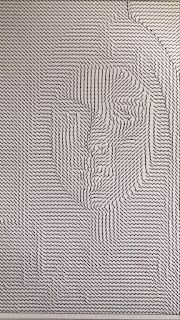Code14: Exploring the Boundaries of Plotter Art
Where machines draw on wet paper, plotters attempt to sing, and algorithms take physical form
Plotting Across Borders
These plots were all printed in India, a detail that feels significant somehow—algorithms traveling across continents to materialize through pen and paper. There's something beautifully contradictory about using cutting-edge technology to create art through one of the most ancient interfaces: ink meeting paper. 
At Brahman.ai, I finally got my hands on an AxiDraw plotter—or rather, I got to watch one interpret my digital creations with mechanical precision. Despite limited access to this fascinating machine, I managed to explore some concepts that have been haunting my creative process for months.
The Wet Paper Experiments
Some of my most interesting results came from plotting on wet paper—watching as the ink bloomed and bled beyond the plotter's precise intentions. This collaboration between mechanical exactitude and material unpredictability created a dialogue I hadn't anticipated.
I transferred several of my existing illustrations to the plotter, including "My Baby Don't Let Me Cry," which took on a completely different emotional quality when rendered by machine on dampened paper. The bleeding lines suggested tears in a way my digital version never could.
The sunset piece transformed similarly—the spreading ink creating atmospheric effects that mimicked the diffusion of light. My self-portrait became less about accurate representation and more about watching my digital identity dissolve into the physical medium.
The Singing Plotter Dream
One of my most ambitious ideas was to create drawings that not only look good but sound good too. I developed patterns specifically to make the AxiDraw "sing" as it moved across the paper—the mechanical symphony of stepper motors becoming an intentional composition rather than an incidental byproduct.

If any plotter enthusiasts have explored this territory, I'd love to hear your experiences. There's something philosophically compelling about art that exists simultaneously as visual object and sonic performance.
Ghosla: Nested Complexity
Among my pending designs for the AxiDraw, "Ghosla" (meaning "nest" in Hindi) holds special promise. The intricately layered patterns create a sense of depth that seems to transcend the flatness of the paper.

Mechanical Portraiture
The portrait experiments were particularly revealing. Watching the plotter render Trishla's features transformed the intimate act of portraiture into something more detached yet somehow still personal. The resulting image exists in an uncanny space between handmade and machine-made—recognizably human yet filtered through algorithmic interpretation.
The mechanical nature of the plotter forces you to consider portraiture differently—breaking down facial features into plottable paths, finding the essence of a person through vectors and movement rather than through traditional mark-making.
Amaze Circles & Geometric Explorations
The "Amaze Circles" series revealed the hypnotic precision possible with the plotter. These intricate circular patterns demonstrate the AxiDraw's capability to produce complex, geometric designs with a consistency impossible for human hands.
What fascinates me about these pieces is the tension between their digital origins and physical manifestation. The patterns began as abstract mathematical relationships, became digital designs, and finally transformed into physical artifacts that carry the slight imperfections of pen, paper, and mechanical movement.
Embracing the Noise
It's fascinating to see how the plotter interprets and reproduces human features. The resulting image has a unique aesthetic that blends mechanical precision with artistic interpretation.
Amaze Circles
Another exciting experiment I conducted was creating what I call "Amaze Circles."
These intricate circular patterns demonstrate the Axidraw's capability to produce complex, geometric designs with remarkable accuracy.
Embracing the Noise
Some of my favorite experiments involved embracing and manipulating various forms of "noise" in the plotter's output.
The Good Noise
Another Noise Experiment
I also explored a different type of noise, resulting in this intriguing piece:
The unpredictability of these noise-based experiments often leads to surprising and aesthetically pleasing results.
Reflections and Future Directions
While my time with the Axidraw was limited, these experiments have opened up a world of possibilities. From attempting to create audible art to exploring various visual techniques, each experiment has taught me something new about the capabilities of plotter art.
I'm particularly interested in further exploring the concept of "singing" plotters and diving deeper into portrait creation. The intersection of traditional art forms with the precision of machine-drawn lines continues to fascinate me.
What do you think about these experiments? Have you tried similar techniques with your plotter? I'd love to hear about your experiences and ideas in the comments below.
Stay tuned for more plotter adventures, and remember - in the world of digital art, the only limit is your imagination (and maybe your plotter's servo motor lifespan)!






































Comments
Post a Comment